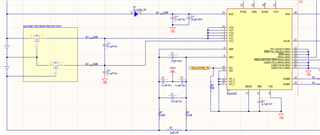Tool/software:
dear,
thanks for your answer.
With your permission, I want to double-check the issue -
I mean that once I configure all the parameters such as overcurrent, minimum cell voltage, setting the function of each leg, for example PCHG, etc. - are all of these saved when power is disconnected totally from the component or does everything have to be reconfigured when power is reconnected?
Another question -
I previously contacted you for help regarding protecting the battery inputs (VC1 - VC6) from reverse voltage that may be caused by connecting a battery or batteries in reverse, and you did not have a solution for this (see previous thread). The issue is very important and is a safety issue to prevent damage to the component or battery and I would greatly appreciate if you could provide a solution for this. I have thought of some solution and would be happy to hear your opinion - see attached drawing. Will these 2 PMOS transistors protect the component from reverse battery connection?

thanks for all the help
regards


